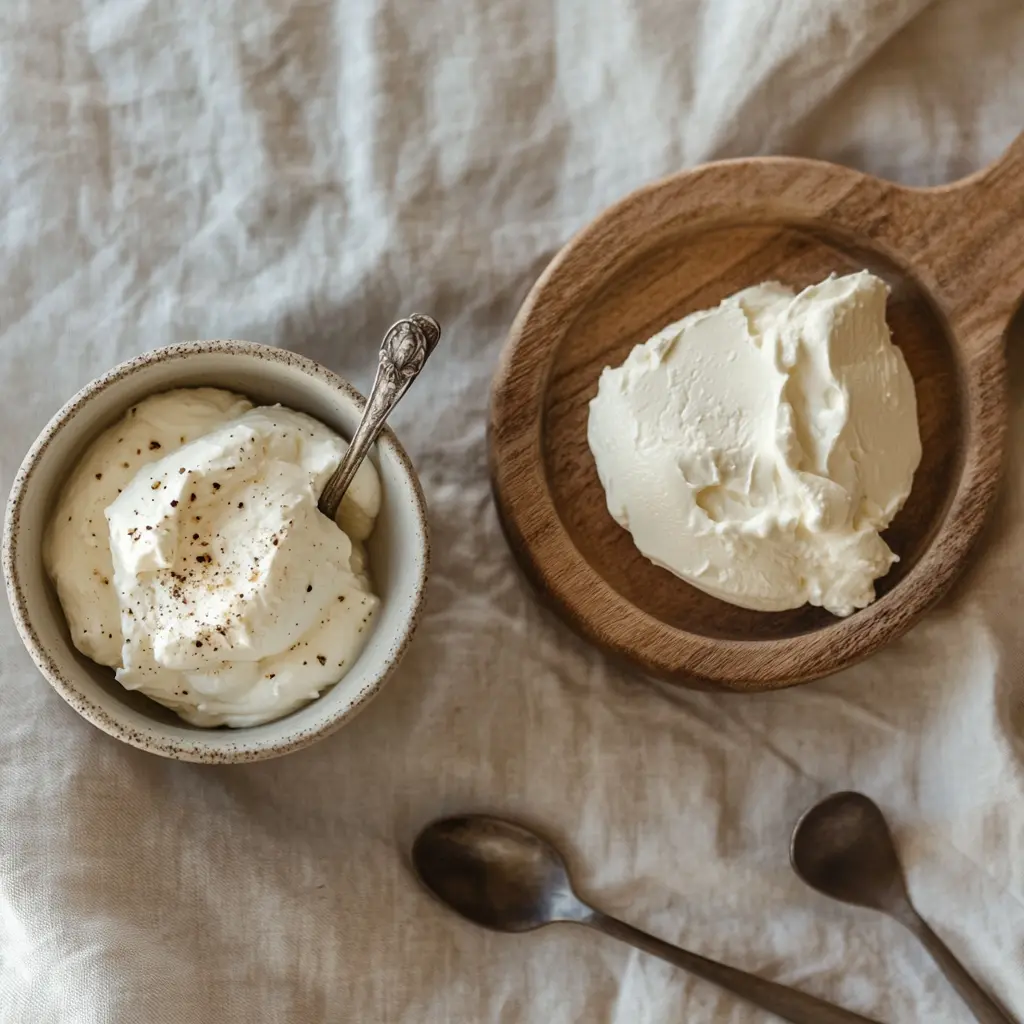Does mascarpone taste different than cream cheese? Many people wonder because these two cheeses look similar and often appear in recipes for sweet and savory dishes. The answer lies in their unique flavors, textures, and uses in cooking.
Mascarpone tastes rich, creamy, and subtly sweet, while cream cheese delivers a tangy, firmer profile. These differences make mascarpone the go-to choice for desserts like tiramisu, while cream cheese works best in cheesecakes or as a spread. In this guide, we’ll explore the key differences between mascarpone and cream cheese and how to use them to elevate your recipes.
Why the Comparison Is Common
Many people compare mascarpone and cream cheese because they share a similar look and texture. Both add creaminess to sweet and savory dishes, making them popular choices in cooking and baking.
Mascarpone often enhances desserts like tiramisu, while cream cheese creates the base for cheesecakes. These shared uses lead cooks to think about swapping one for the other in recipes.
Stores frequently stock mascarpone and cream cheese in the same refrigerated section. Shoppers who notice them side by side often wonder how they differ and whether one can replace the other.
Both cheeses work well in spreads, dips, and fillings, which makes them seem interchangeable. Despite these similarities, mascarpone’s mild sweetness and cream cheese’s tangy flavor give each a unique role in recipes.
What Is Mascarpone and How Does It Taste?
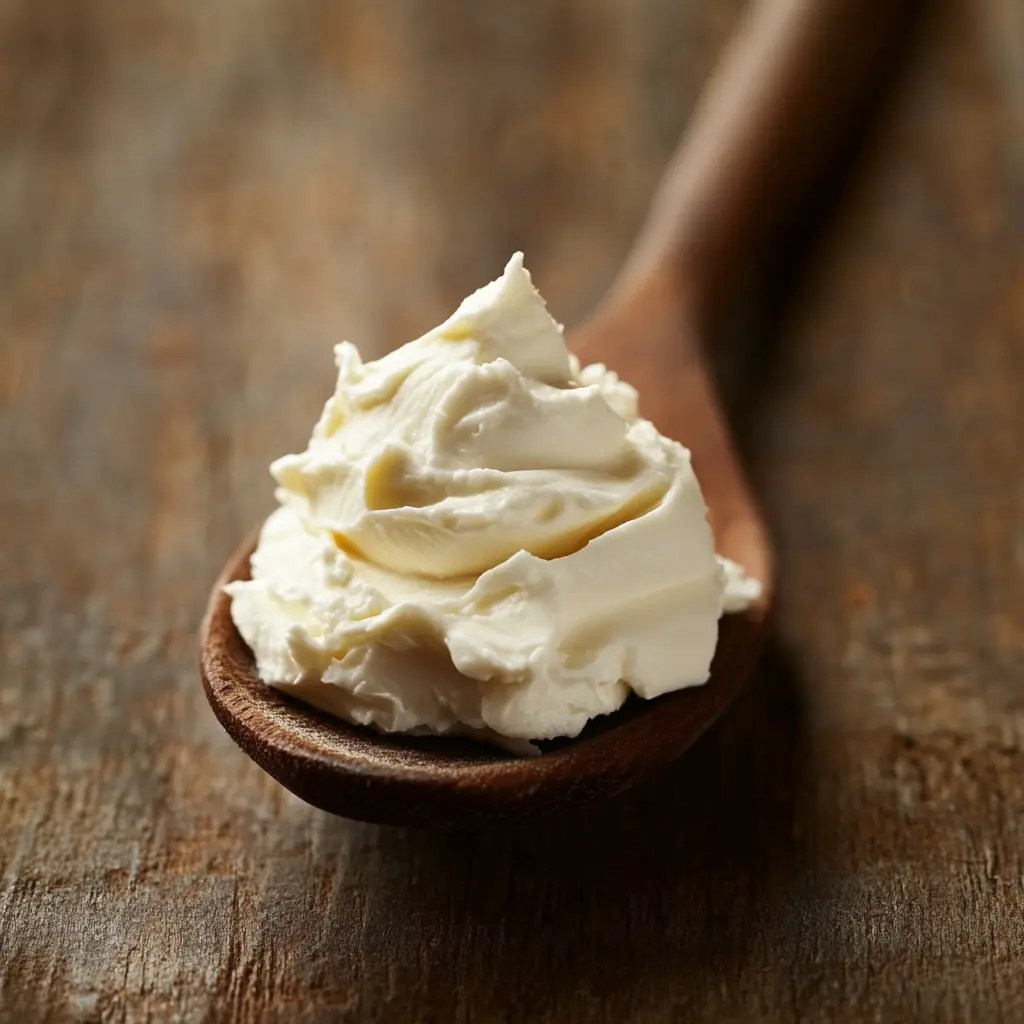
Does mascarpone taste different than cream cheese in flavor and texture?
Mascarpone is a rich, creamy cheese from Italy, known for its smooth texture and subtle sweetness. Its high fat content makes it ideal for luxurious dishes, but how does mascarpone taste different than cream cheese? Unlike cream cheese, mascarpone’s flavor lacks tanginess, offering a buttery, mild profile instead.
Mascarpone plays a central role in Italian cuisine. Its rich, buttery taste and velvety texture make it perfect for luxurious dishes. Does mascarpone taste different than cream cheese? Absolutely, and it starts with how mascarpone is made.
Mascarpone uses heavy cream and an acid, such as lemon juice, to create a soft, creamy cheese. Its high fat content, ranging between 60% and 75%, gives it an indulgent feel. Unlike cream cheese, mascarpone doesn’t include added stabilizers or fermentation, keeping its flavor mild and naturally sweet.
Origins and History of Mascarpone
Mascarpone originated in the Lombardy region of northern Italy during the late Renaissance period. Farmers in the area developed this rich, creamy cheese by curdling heavy cream with acidic agents like lemon juice or vinegar. Its name likely comes from the local dialect word “mascherpa,” which refers to cream or a cream-based product.
Italian cooks quickly embraced mascarpone for its luxurious texture and mild flavor. They used it in both sweet and savory recipes, including desserts like tiramisu and creamy risottos. Over time, mascarpone became a staple ingredient in Italian cuisine, symbolizing indulgence and simplicity.
Today, mascarpone remains a key component of classic Italian dishes and has gained popularity worldwide. Chefs and home cooks use it to create rich sauces, elegant desserts, and even unique takes on traditional recipes. Its deep ties to Italian culinary heritage make it a timeless favorite.
Ingredients and Production Process
Mascarpone uses simple ingredients and a straightforward production process, giving it its signature creamy texture and rich flavor.
Ingredients
Producers make mascarpone with just two main ingredients:
- Heavy Cream: The base of mascarpone, providing its rich, buttery consistency.
- Acid (Lemon Juice or Citric Acid): Used to thicken the cream and create curds.
Unlike many cheeses, mascarpone doesn’t include cultures, rennet, or additional flavorings, keeping its taste mild and pure.
Production Process
- Heating the Cream: The process begins by gently heating heavy cream to a specific temperature, usually around 185°F (85°C).
- Adding Acid: Lemon juice or citric acid gets stirred into the warm cream, causing it to thicken as curds form.
- Straining: The thickened mixture is strained through a fine cloth or sieve to remove excess liquid, leaving behind the creamy, rich mascarpone.
- Cooling and Packaging: Once strained, the mascarpone is cooled and packaged, ready for use in both sweet and savory dishes.
This simple process creates mascarpone’s smooth, velvety texture and mild, slightly sweet flavor, making it a favorite in traditional and modern recipes alike.
If you’re curious to dive deeper into the unique flavor profile of mascarpone, don’t miss this detailed guide: What Does Mascarpone Taste Like? Discover Its Creamy Flavor.
Texture and Taste Profile: Creaminess and Subtle Sweetness
Mascarpone stands out for its luxurious texture and mild, slightly sweet flavor.
Texture
Mascarpone feels incredibly smooth and velvety, thanks to its high fat content, which ranges between 60% and 75%. Its soft, spreadable consistency allows it to blend effortlessly into recipes, making it ideal for creamy desserts and sauces. Unlike firmer cheeses, mascarpone doesn’t require slicing and spreads easily right out of the container.
Taste
The flavor of mascarpone leans toward mild and slightly sweet. It lacks the tanginess found in cream cheese, offering a more buttery and neutral profile. This subtle sweetness enhances both sweet and savory dishes without overpowering other ingredients.
Mascarpone’s creamy texture and delicate flavor make it a versatile ingredient, especially in recipes that demand richness and smoothness. Whether layered in a tiramisu, swirled into a pasta sauce, or spread on toast, mascarpone delivers a hint of indulgence to every dish.
What Is Cream Cheese and How Does It Compare to Mascarpone?
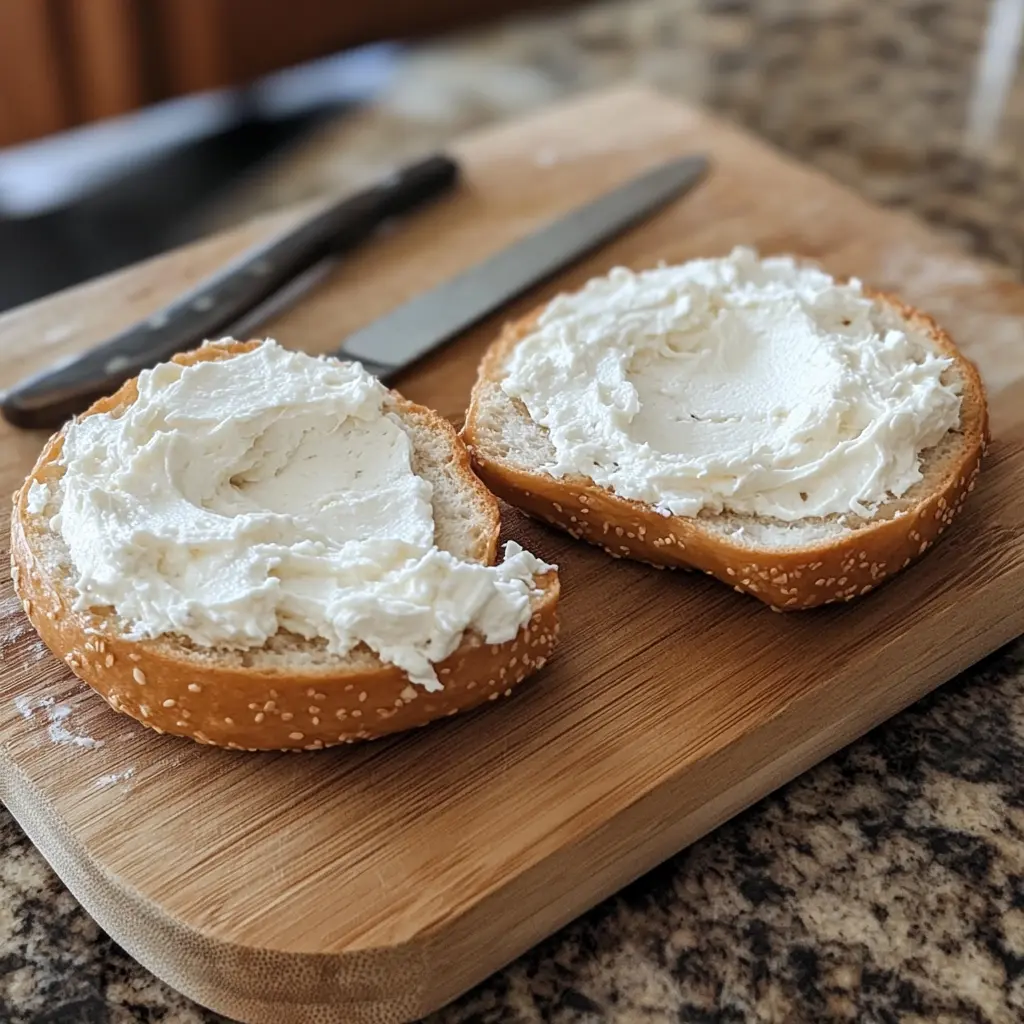
Does mascarpone taste different than cream cheese in cooking?
Cream cheese, developed in the United States, provides a tangy, firmer alternative to mascarpone. Its fermentation process gives it a bolder flavor, making it perfect for cheesecakes and savory spreads. The question arises: does mascarpone taste different than cream cheese in versatility? Yes, cream cheese holds its shape better, while mascarpone excels in creamy, delicate recipes.
Key Differences: Does Mascarpone Taste Different Than Cream Cheese?
Fat Content and Consistency
Does mascarpone taste different than cream cheese when you use them in recipes? Here’s how their distinct characteristics compare:
- Fat Content and Consistency: Mascarpone has a higher fat content (60-75%) compared to cream cheese (33%), making it creamier and softer. Cream cheese’s firmness gives it more structure in recipes like baked cheesecakes.
- Flavor Intensity: Mascarpone tastes mild, sweet, and buttery, while cream cheese has a tangy and slightly salty flavor.
- Culinary Uses: Mascarpone stars in tiramisu, creamy sauces, and spreads. Cream cheese works in bagel spreads, dips, and New York-style cheesecakes.
Cultural and Culinary Uses
Mascarpone Uses
Mascarpone holds a central place in Italian cuisine. It features prominently in desserts like tiramisu and cannoli, where its creamy texture and mild flavor enhance sweetness. Chefs also use mascarpone in savory dishes, such as pasta sauces and risottos, where it adds richness without overwhelming the dish.
Cream Cheese
Cream cheese has become a staple in Western cuisine, especially in the United States. It often appears in cheesecakes, frostings, and bagel spreads. Its tangy flavor works beautifully in savory dips, stuffed vegetables, and smoked salmon spreads. Its versatility and affordability make it a go-to ingredient for both home cooks and professionals.
These distinct cultural and culinary roles highlight how each cheese shines in different contexts. Mascarpone emphasizes indulgence and subtlety, while cream cheese offers boldness and practicality.
How Mascarpone and Cream Cheese Are Used in Cooking
Does mascarpone taste different than cream cheese in sweet or savory dishes? Yes, and these differences influence how they work in recipes.
- Sweet Dishes: Mascarpone creates the rich layers in tiramisu, while cream cheese provides the tangy base for classic cheesecakes.
- Savory Dishes: Mascarpone adds creaminess to pasta sauces and spreads, while cream cheese holds up well in baked dips and hearty appetizers.
- Substitutions: You can swap one for the other in certain recipes, but adjust for mascarpone’s creaminess or cream cheese’s tang.
Sweet Dishes: Tiramisu vs. Cheesecakes
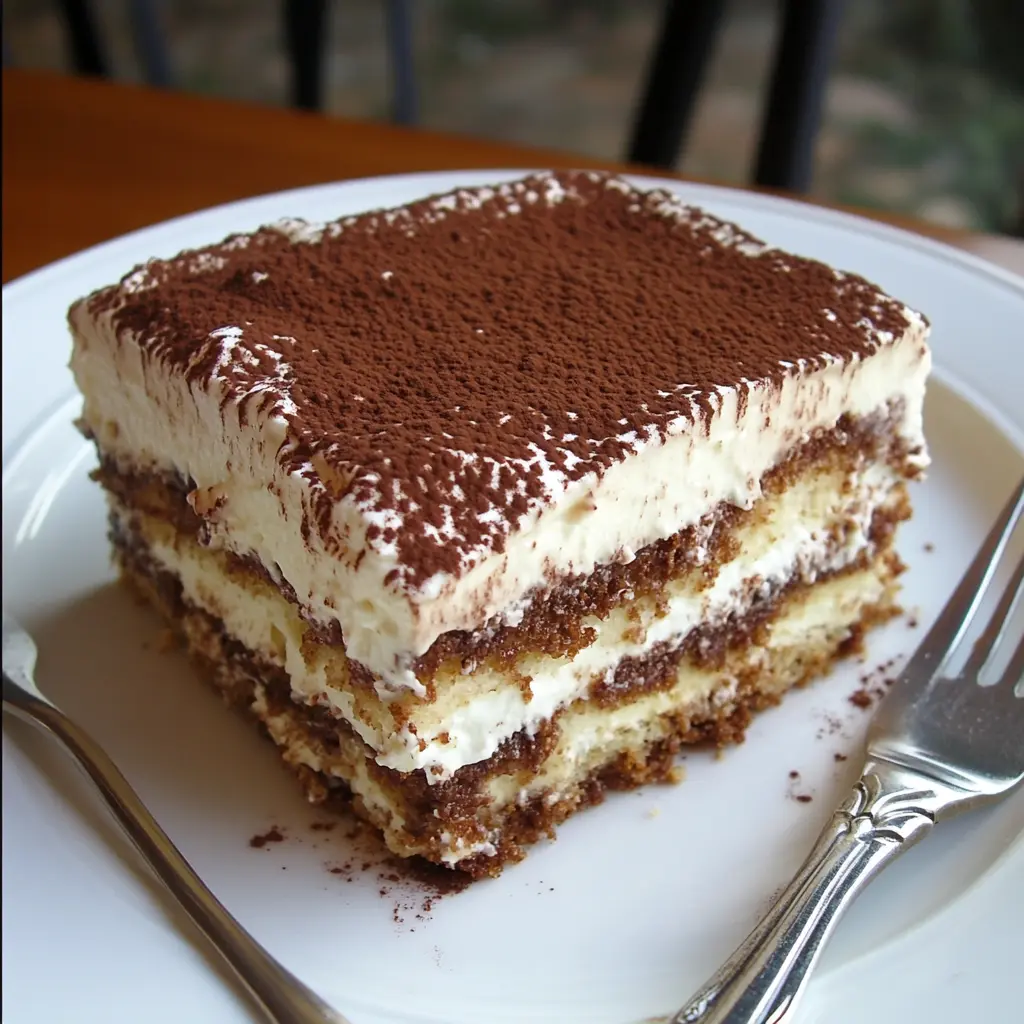
Tiramisu with Mascarpone
Mascarpone plays a starring role in tiramisu, one of the most iconic Italian desserts. Its creamy texture and mild sweetness blend seamlessly with espresso-soaked ladyfingers and cocoa powder. Mascarpone doesn’t just add richness; it creates the silky, indulgent layers that define tiramisu.
In tiramisu, mascarpone’s subtle flavor lets the boldness of coffee, chocolate, and liqueur shine. Because it spreads and whips easily, mascarpone helps create the dessert’s signature light yet creamy texture. Using cream cheese in tiramisu would result in a tangier flavor, which may not match the dessert’s traditional profile.
Cheesecakes with Cream Cheese
Cream cheese dominates cheesecake recipes worldwide, particularly in American-style cheesecakes. Its tangy flavor contrasts perfectly with the sweetness of sugar, while its firmer texture provides the structure needed for a dense, sliceable cake.
Cream cheese holds its shape during baking, ensuring a smooth, creamy consistency without collapsing. Its bold taste also pairs well with a variety of toppings, from fresh fruit to chocolate ganache, making it a versatile base for countless cheesecake variations.
Key Difference
While both mascarpone and cream cheese work in sweet dishes, their flavors and textures suit different recipes. Mascarpone’s richness and subtlety enhance desserts like tiramisu, where creaminess takes center stage. Cream cheese, with its tangy, bold profile, defines the flavor and structure of a classic cheesecake.
Savory Dishes: Dips, Pasta, and Spreads
Dips
Mascarpone brings a rich, creamy base to savory dips, such as spinach and artichoke dip or roasted garlic spread. Its mild flavor lets other ingredients shine while adding a luxurious texture. In contrast, cream cheese offers a tangy punch that enhances bold flavors like jalapeño or smoked salmon. Its firmer consistency also helps dips hold their shape better when scooped or baked.
Pasta
Mascarpone works beautifully in creamy pasta sauces, lending a smooth, velvety texture without overpowering the dish. For example, a mascarpone-based sauce with fresh herbs or Parmesan creates a lighter, silkier alternative to Alfredo. Cream cheese can substitute in a pinch, but its tangy flavor may alter the dish’s profile. Mascarpone’s subtle sweetness makes it a better fit for traditional Italian recipes.
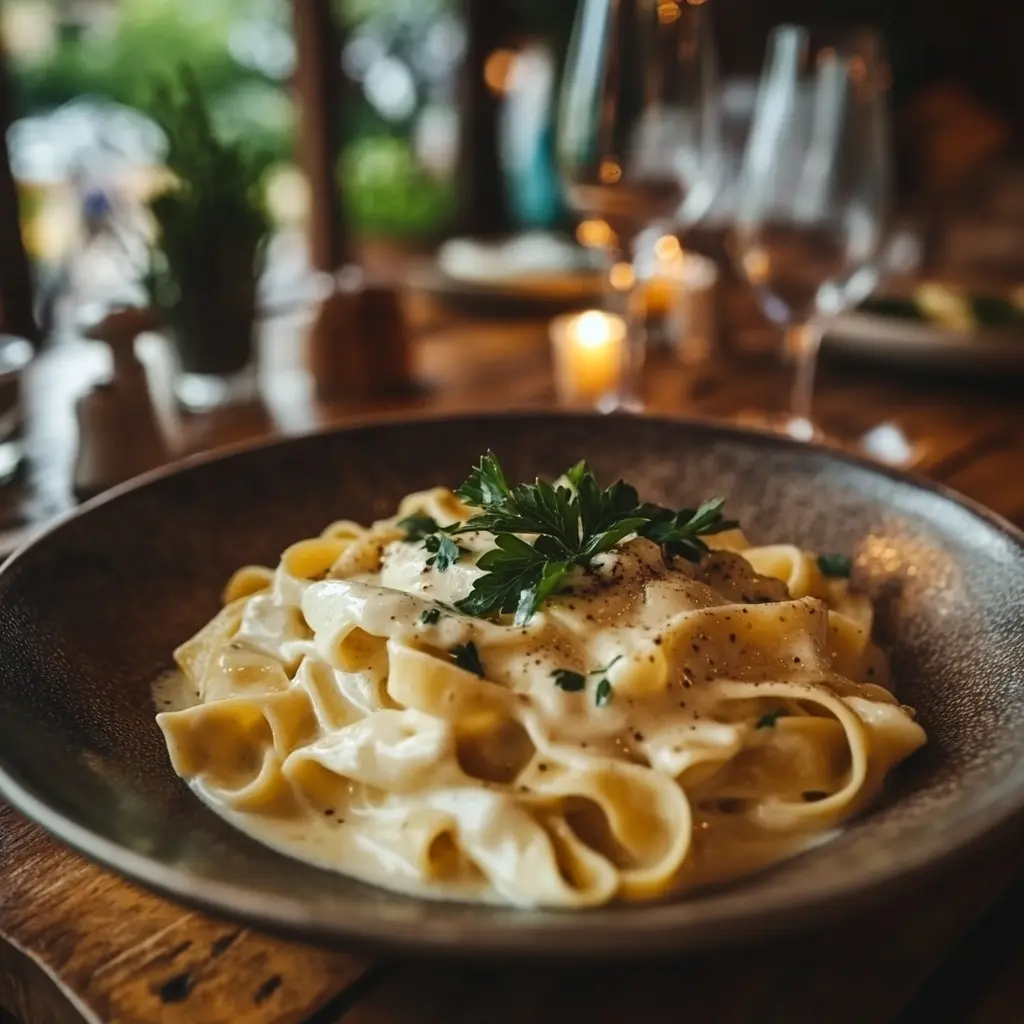
Spreads
Mascarpone creates elegant spreads when blended with herbs, spices, or smoked fish. It spreads easily on toast or crackers, adding a touch of sophistication. Cream cheese, with its firmer texture and tang, works well in heartier spreads like chive and onion or salmon mousse. Its bolder flavor complements robust ingredients, making it a staple in savory spreads for bagels and appetizers.
Substitutions: When and How to Swap Them
You can substitute mascarpone and cream cheese in certain recipes, but their distinct flavors and textures require adjustments.
When to Use Mascarpone Instead of Cream Cheese
Mascarpone works as a substitute when you need a creamier, milder flavor. Add it to cheesecakes, dips, or frostings for a softer texture. However, since mascarpone contains more fat, it may create a richer result. For best results, combine mascarpone with a small amount of cream cheese if the recipe requires tanginess or firmness.
When to Use Cream Cheese Instead of Mascarpone
Cream cheese can replace mascarpone in recipes that don’t depend heavily on mascarpone’s sweetness or texture. For example, in tiramisu, mix cream cheese with a bit of heavy cream to mimic mascarpone’s smoothness. However, the tanginess of cream cheese will alter the flavor, making it less traditional.
Key Tips for Swapping
- To replicate mascarpone’s creaminess, mix cream cheese with heavy cream or butter.
- To achieve a tangier mascarpone alternative, add a small amount of lemon juice to mascarpone.
- Use mascarpone for mild, creamy dishes and cream cheese when you need tang and structure.
Choosing the right substitution depends on the recipe’s flavor and texture requirements. Adjust carefully to preserve the dish’s balance.
Nutritional Comparison
Calorie Count and Macronutrient Breakdown
Mascarpone
Mascarpone contains a higher calorie and fat content due to its rich cream base. A 1-ounce (28-gram) serving of mascarpone provides:
- Calories: 120
- Fat: 11 grams
- Protein: 1 gram
- Carbohydrates: 1 gram
Most of mascarpone’s calories come from fat, making it a high-calorie choice that adds richness to dishes. Its lower protein content makes it less filling compared to other cheeses.
Cream Cheese
Cream cheese offers fewer calories and less fat per serving but contains slightly more protein. A 1-ounce (28-gram) serving of cream cheese provides:
- Calories: 100
- Fat: 9 grams
- Protein: 2 grams
- Carbohydrates: 1 gram
While cream cheese contains less fat, it still contributes richness to recipes, with a tangy flavor and slightly more protein per serving.
Which Is Healthier for Specific Diets
Low-Calorie Diets
For those watching their calorie intake, cream cheese makes the better choice. It contains fewer calories and less fat than mascarpone, making it easier to include in moderation without overloading on calories.
High-Fat or Keto Diets
Mascarpone works well in high-fat diets, such as keto. Its higher fat content and lower carbohydrate count align with the macronutrient ratios required for ketosis. The creamy, satisfying texture of mascarpone also makes it a great choice for keto-friendly desserts and sauces.
High-Protein Diets
While neither mascarpone nor cream cheese qualifies as a high-protein food, cream cheese contains slightly more protein per serving. Those aiming to increase their protein intake should still pair these cheeses with protein-rich ingredients like nuts, eggs, or lean meats.
Lactose Sensitivity
Both mascarpone and cream cheese contain lactose, but mascarpone’s higher fat content may make it easier for some people to digest. Individuals with lactose intolerance should still consume these cheeses cautiously or look for lactose-free options.
Frequently Asked Questions (FAQs)
Can You Use Mascarpone Instead of Cream Cheese?
Yes, you can use mascarpone instead of cream cheese in many recipes, but expect differences in flavor and texture. Mascarpone’s mild sweetness and higher fat content make it creamier and less tangy than cream cheese. To mimic cream cheese’s tang, you can mix mascarpone with a small amount of lemon juice or yogurt.
Is Mascarpone Sweeter Than Cream Cheese?
Yes, mascarpone tastes naturally sweeter and milder compared to cream cheese. Cream cheese has a tangy, slightly salty flavor, which gives it a more distinct taste. Mascarpone’s subtle sweetness works well in desserts, while cream cheese’s tang pairs perfectly with bold flavors in sweet or savory dishes.
Why Does Mascarpone Cost More?
Mascarpone costs more because it uses more heavy cream in its production, resulting in a higher fat content and a luxurious texture. Additionally, mascarpone is often imported from Italy, which increases its price. Cream cheese, mass-produced in larger quantities, is more affordable and widely available.
How Long Do Mascarpone and Cream Cheese Last After Opening?
Mascarpone lasts about 5 to 7 days after opening when stored in the refrigerator, while cream cheese can last up to 2 weeks if kept sealed and cold. Both should be stored in airtight containers to maintain freshness. Always check for changes in smell, texture, or color before using.
Conclusion
Mascarpone and cream cheese may share some similarities, but their differences in flavor, texture, and culinary uses set them apart. Mascarpone, with its rich, buttery consistency and subtle sweetness, shines in luxurious desserts like tiramisu and creamy pasta sauces. Cream cheese, on the other hand, offers a tangy flavor and firmer texture, making it perfect for cheesecakes, spreads, and savory dips.
Choosing between the two depends on the recipe and the flavor profile you want to achieve. Use mascarpone for indulgent, smooth dishes that call for a neutral taste. Opt for cream cheese when you need a bold, tangy flavor or more structure in your dish.
Both mascarpone and cream cheese bring versatility and richness to a variety of recipes. Understanding their unique qualities allows you to select the right ingredient to elevate your cooking and baking. Whether you’re preparing a classic Italian tiramisu or a New York-style cheesecake, knowing how to use these two cheeses ensures delicious results every time.
If you’re curious to dive deeper into the unique flavor profile of mascarpone, don’t miss this detailed guide: What Does Mascarpone Taste Like? Discover Its Creamy Flavor. This resource explores its rich, buttery taste and how it enhances both sweet and savory dishes, giving you even more reasons to include mascarpone in your next recipe.

